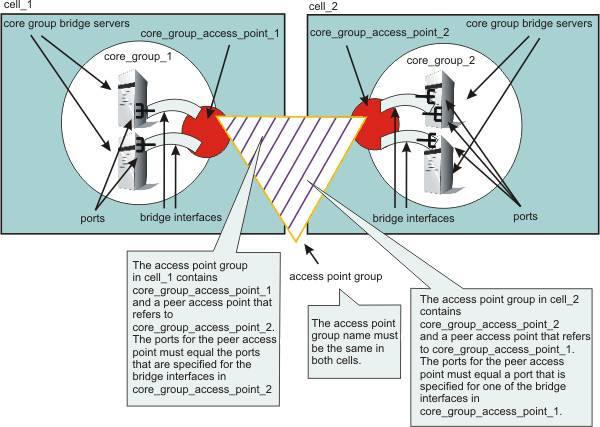Core group communications using the core group bridge service
Overview
The core group bridge service can be configured to share availability information about internal WAS components between core groups.
For example each core group can be aware of the status of all of the appservers that are configured in all of the core groups. Use access point groups to define the core groups that communicate. Do not use the core group bridge service to share application information among core groups.
A core group is a statically defined component of the high availability manager. Each cell must have at least one core group. WAS creates a default core group called DefaultCoreGroup for each cell.
Two or more core groups can be set up to communicate with each other and share workload management information by defining access point groups. The core groups that communicate can be in the same cell or in different cells.
To configure communication between core groups, configure an access point group. An access point group is a collection of the core groups that communicate with each other. Add a core group access point to the access point group for each core group that needs to communicate.
A core group access point is a collection of server, node, and transport channel chain combinations that communicate for the core group. Each core group has one or more defined core group access points. The DefaultCoreGroup has one default core group access point. However, you might consider configuring more than one core group access point for a core group if that particular core group needs to be connected to other core groups that are on different networks.
The node, server, and transport channel chain combinations that are in a core group access point are called bridge interfaces. A server that hosts the bridge interfaces is a core group bridge server. The transport channel chain defines the set of channels that are used to communicate with other core group bridge servers. Each transport channel chain has a configured port that the core group bridge server uses to listen for messages from other core group bridge servers.
Each core group access point must have at least one core group bridge server. The core group bridge server provides the bridge interface for each core group access point. Because core group bridge servers within a core group access point serve as backups for each other, it is recommended that you have two core group bridge servers within each core group access point. Then, if one core group bridge server fails, the other core group bridge server can take over the failed core group bridge server's responsibilities.
If you are configuring communication between core groups that are in the same cell, create one access point group and add a core group access point for each core group that needs to communicate.
If you are configuring the core group bridge between core groups that are in different cells, you still use an access point group. However, create and configure the access point group for each cell. Each cell has an access point group that contains a core group access point for the core group that is in the cell, and a peer access point for each peer cell.
A peer access point references a core group access point that is configured in a different cell. Each access point group must have one peer access point for each different cell. Do not configure multiple peer access points that reference the same cell.
Each peer access point has one or more peer ports or one proxy peer access point.
A peer port corresponds to a bridge interface that is defined in the peer cell. You can define several peer ports for each peer access point.
Define a proxy peer access point if the peer access point cannot be reached directly by using a peer port, but can be reached by using another peer access point. The proxy peer access point specifies a peer access point that can communicate with the peer core group that cannot be reached directly. The proxy peer must have defined peer ports. Specify one proxy peer or one or more peer ports, but not both.
The following diagram shows a core group bridge configuration between two different cells that is using peer access points with peer ports. Figure 1. Core group bridge configuration in two different cells

Related concepts
Advanced core group bridge configurations